The Willis: A Journey to Late Night with Jimmy Fallon
Today I heard from a handsome gentleman, who also happens to be a member of my favorite band in hibernation, and I gotta tell you, I'm picking up good vibrations.
The Willis is coming out of hibernation to fly to New York and play on a live taping (not to be broadcast) of Late Night with Jimmy Fallon on Thursday, Feb 26th.
Are you thinking what I was thinking?
Me: "What does 'not to be broadcast' mean?", I begged.
He: "It means they're 'not going to broadcast it,'" explained the handsome guy. "Broadcast episodes, I guess, start on March 2nd. It's a show that prepares the staff, etc. Should be good fun, though..."
Me: "I hope this means you're going to get around to more gigging soon!"
He: "We'll see...Just finishing my book/dissertation, so I might have more time."
[where: The Willis, 55406]
Shanty Confessionals
Last Saturday, we pulled on long underwear, wrapped ourselves from head to toe, grabbed some coffee, and headed out to check out the Art Shanty Projects 2009 installation on Medicine Lake.
It was a perfect day for it: frigidly cold and windy with sunshine and blue skies.
My favorite art shanty was the Art Shanty Confessional. Sure, I was raised Catholic, but I've only been to confession once. This confession shanty was more fun than the confessional of my childhood.
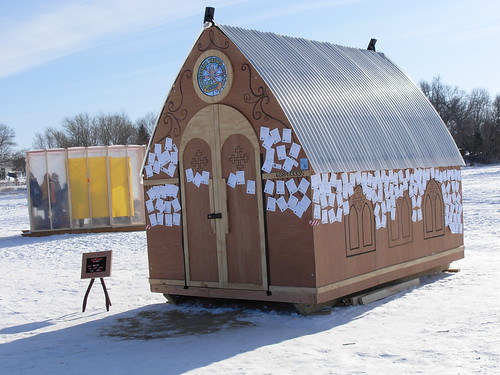
People wrote their confessions on slips of paper that read: "Welcome. It's our pleasure to save you. Remember, two things: 1) Good penmanship is next to Godliness, 2) No last names, please. Confess something here: " The shanty folks then stapled the written confessions to the outer wall of the shanty. I grabbed a few snapshots of some of the confessions that made me laugh (No one told me to stop, so I don't think I broke any rules. If I did, let me know please):

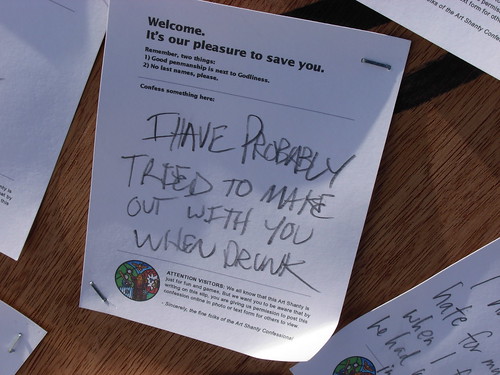

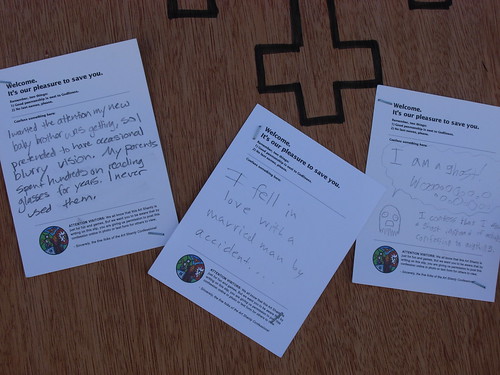
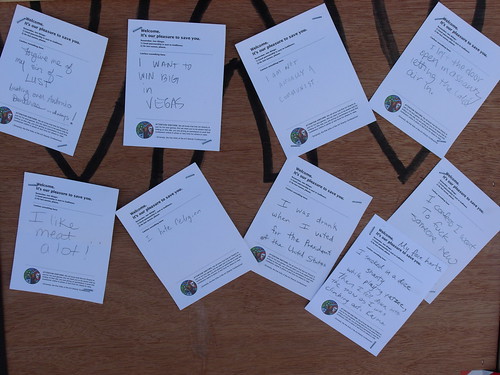
The shanties are open to the public every Saturday and Sunday on Medicine Lake, 11am - 4pm, through February 14.
You can check out our whole set of photos from the Art Shanty Project 2009 here.
[where: 55406]
It was a perfect day for it: frigidly cold and windy with sunshine and blue skies.
My favorite art shanty was the Art Shanty Confessional. Sure, I was raised Catholic, but I've only been to confession once. This confession shanty was more fun than the confessional of my childhood.

People wrote their confessions on slips of paper that read: "Welcome. It's our pleasure to save you. Remember, two things: 1) Good penmanship is next to Godliness, 2) No last names, please. Confess something here: " The shanty folks then stapled the written confessions to the outer wall of the shanty. I grabbed a few snapshots of some of the confessions that made me laugh (No one told me to stop, so I don't think I broke any rules. If I did, let me know please):
click on any of the images to see a larger version





The shanties are open to the public every Saturday and Sunday on Medicine Lake, 11am - 4pm, through February 14.
You can check out our whole set of photos from the Art Shanty Project 2009 here.
[where: 55406]
Clicquot Club Cafe Closes its Doors
A restaurant in our neck of the non-woods is out of business. Clicquot Club Cafe has closed its doors.
This was the restaurant housed in the Seward neighborhood's "Orange Crush" building.
It was a cozy, happy little cafe with a smart outdoor seating area and an extensive menu featuring handmade pizzas, paninis, sandwiches, soups, and salads. I will miss their ham and jalsburg sandwich, the giant Dagwood sandwich, and their salami/mozzarella panini.
I bought my bulk tea there on more than one occasion - they had an awesome mango green tea that I bought by the jarful.
From their website:
It is with sadness and regret that we have decided to close our doors, effective January 12th, 2009.
After 3 wonderful years we find ourselves in a situation where sales have fallen to unsustainable levels and we have no other choice but to cease operations.
We’d like to thank everyone that has supported us and want our loyal customers to know how much we have truly appreciated you over the last years. It’s been an incredible experience, and serving this community has been the greatest reward anyone could imagine.
Although these are challenging times, we know that there are other opportunities ahead, and we thank you for supporting us through both the best, and worst, of times.
We’re honored to have been part of your lives!
Thank You…
PS - This is a crosspost from my other blog.
[where: Minneapolis, Twin Cities, 55406]
This was the restaurant housed in the Seward neighborhood's "Orange Crush" building.
It was a cozy, happy little cafe with a smart outdoor seating area and an extensive menu featuring handmade pizzas, paninis, sandwiches, soups, and salads. I will miss their ham and jalsburg sandwich, the giant Dagwood sandwich, and their salami/mozzarella panini.
I bought my bulk tea there on more than one occasion - they had an awesome mango green tea that I bought by the jarful.
From their website:
It is with sadness and regret that we have decided to close our doors, effective January 12th, 2009.
After 3 wonderful years we find ourselves in a situation where sales have fallen to unsustainable levels and we have no other choice but to cease operations.
We’d like to thank everyone that has supported us and want our loyal customers to know how much we have truly appreciated you over the last years. It’s been an incredible experience, and serving this community has been the greatest reward anyone could imagine.
Although these are challenging times, we know that there are other opportunities ahead, and we thank you for supporting us through both the best, and worst, of times.
We’re honored to have been part of your lives!
Thank You…
PS - This is a crosspost from my other blog.
[where: Minneapolis, Twin Cities, 55406]
Your Fortune: You'll Find Something Tasty at United Noodles
I've been feeling a little more upbeat lately. It might be because of Michelle Obama's scandalous audience winks, or it might be because we live very near to United Noodles in Minneapolis.
Now, I'm sure most MPLS food lovers have visited United Noodles, but on the off chance that you might have missed it, like we had, I'm here to tell you it's worth checking out.
United Noodles is a 15,000 square foot market containing more than 8,000 (mostly grocery) items from more than 15 countries including China, Japan, Taiwan, Hong Kong, Vietnam, Thailand, Indonesia, Malaysia, Singapore, Korea, India, Sri Lanka and the Philippines.
Being a dumpling freak, I was interested in checking out just how much United Noodles could offer me in terms of dumplings. Silly me, I didn't count the options because I was literally too excited to count. They've got everything you need to prepare jiaozi, wontons, and gyoza from scratch - or any other delicious Asian dumpling variety you can imagine, for that matter. For the less ambitious, they also host an ENTIRE BANK of freezers stuffed with various versions of frozen dumpling varieties. Seriously, I'm talking about dozens and dozens of meat, seafood, and vegetarian varieties of the frozen little delights, which are prepared with ease in 10 minutes on your stovetop.
They stock far more than dumplings, of course, including fresh specialty produce, dozens of varieties of dried and fresh noodles, varieties of tofu, seafood, sauces, mock meats, candies, snacks, fresh herbs, cookies, beverages, energy drinks, seasoning, cookware, serveware, teas, etc.
Obviously, I was starving after peeping all those dumplings, so we grabbed some lunch while we shopped the market. Lucky for us, they have a hot deli full of tasty-looking eats. They offer homestyle roasted pork and roasted duck daily. They offered no homemade dumplings at the deli, so I almost ordered the much lauded Taiwanese Beef Noodle Soup, but I opted for a daily special:
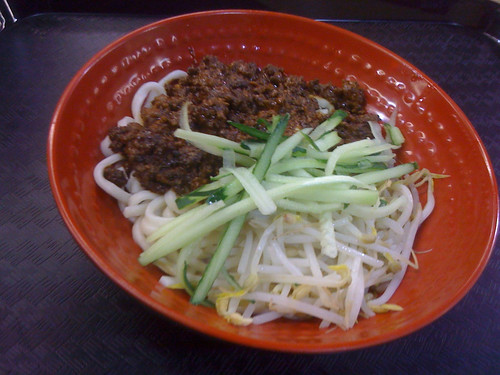
gerg tried their daily pork chop special and commented that it was decent. He waited about 10 minutes for the chop. The pork chop special was served up on a bed of seasoned grilled onions and green peppers with a side of rice, pickled cucumbers, and some of their daily vegetable soup. gerg drank some of the free hot tea they offer.
Not sure what to order? No sweat - they offer free samples. Guess how much we paid for our lunches.......................$4.95 each. Tables are small and limited, and you're expected to bus your table yourself. That ain't no thang.
Deli Hours
Monday: CLOSED
Tuesday to Saturday: 11am - 6pm
Sunday: 11am - 5pm
PS - Amy, your dumplings were totes awesome! Thanks again for the dinner invite! xoxoxo
[where: 55406]
Now, I'm sure most MPLS food lovers have visited United Noodles, but on the off chance that you might have missed it, like we had, I'm here to tell you it's worth checking out.
United Noodles is a 15,000 square foot market containing more than 8,000 (mostly grocery) items from more than 15 countries including China, Japan, Taiwan, Hong Kong, Vietnam, Thailand, Indonesia, Malaysia, Singapore, Korea, India, Sri Lanka and the Philippines.
Being a dumpling freak, I was interested in checking out just how much United Noodles could offer me in terms of dumplings. Silly me, I didn't count the options because I was literally too excited to count. They've got everything you need to prepare jiaozi, wontons, and gyoza from scratch - or any other delicious Asian dumpling variety you can imagine, for that matter. For the less ambitious, they also host an ENTIRE BANK of freezers stuffed with various versions of frozen dumpling varieties. Seriously, I'm talking about dozens and dozens of meat, seafood, and vegetarian varieties of the frozen little delights, which are prepared with ease in 10 minutes on your stovetop.
They stock far more than dumplings, of course, including fresh specialty produce, dozens of varieties of dried and fresh noodles, varieties of tofu, seafood, sauces, mock meats, candies, snacks, fresh herbs, cookies, beverages, energy drinks, seasoning, cookware, serveware, teas, etc.
Obviously, I was starving after peeping all those dumplings, so we grabbed some lunch while we shopped the market. Lucky for us, they have a hot deli full of tasty-looking eats. They offer homestyle roasted pork and roasted duck daily. They offered no homemade dumplings at the deli, so I almost ordered the much lauded Taiwanese Beef Noodle Soup, but I opted for a daily special:

Taiwanese Soy Bean Paste Noodles
This dish was packed with flavor. Nothing fancy, just simple udon noodles topped with highly seasoned crumbled bean curd, sliced cucumber and bean sprouts. It came out to our table in less than 3 minutes. I added some of the spicy garlic sauce they made available on the table. It must have been made with firm/dried bean curd because the crumbles had the firmness of cooked meat, and it was a great platform for the garlicy, tangy, soy-based sauce. The cooks were far too busy to entertain my questions about the dish. I had some free water with my meal.gerg tried their daily pork chop special and commented that it was decent. He waited about 10 minutes for the chop. The pork chop special was served up on a bed of seasoned grilled onions and green peppers with a side of rice, pickled cucumbers, and some of their daily vegetable soup. gerg drank some of the free hot tea they offer.
Not sure what to order? No sweat - they offer free samples. Guess how much we paid for our lunches.......................$4.95 each. Tables are small and limited, and you're expected to bus your table yourself. That ain't no thang.
Monday: CLOSED
Tuesday to Saturday: 11am - 6pm
Sunday: 11am - 5pm
PS - Amy, your dumplings were totes awesome! Thanks again for the dinner invite! xoxoxo
[where: 55406]
Yes, I'm Livin' At A Pace That Kills
Reetsy's Rogues: A Minnesota Horse Logger
Reetsy's Rogues features my kind of daredevils, adventurers, swashbucklers, exemplars, etc. A Reetsy's Rogue is the kind of person who captivates my attention due to an uber adventerous attitude and creative engineering. I was going to stick to midwesterners with this feature, but I'd hate to exclude an acrobatic dolphin slayer from Cuba.
Through my dayjob, I've had the experience of working with Tim Carroll of Cedar River Horse Logging in Lyle, MN.
I saw his horse logging work featured on TPT last year, and I was captivated. The dedication, tradition, and craftsmanship that he invests in his enterprise impressed me.
Here's what I learned after speaking with him:
Having worked at a treatment facility for juveniles for 16 years, Carroll never planned to have a successful career in horse logging. Carroll married his wife, Doreen, who had three riding horses, and he soon grew attached to draft horses and began using them to plow his driveway. Down the road from his home in Minnesota, Carroll noticed a neighbor had hired a machine logger to clear their property of some trees. The loggers had left a mess on his neighbor’s property.
Carroll asked his neighbors if he could come by and clean out some of those logs with his draft horses. It didn’t take long and he had a crowd of people watching. People started asking if he could come out to their land too. Before he had his first job done, he had three contracts waiting. Soon, “equine forestry,” as Carroll calls it, became his new passion.
His horse logging enterprise is going to be spotlighted on Modern Marvels on the History Channel tonight (7pm and 11pm central).
More about tonight's episode of Modern Marvels.
[where: 55406]
Through my dayjob, I've had the experience of working with Tim Carroll of Cedar River Horse Logging in Lyle, MN.
I saw his horse logging work featured on TPT last year, and I was captivated. The dedication, tradition, and craftsmanship that he invests in his enterprise impressed me.
Here's what I learned after speaking with him:
Having worked at a treatment facility for juveniles for 16 years, Carroll never planned to have a successful career in horse logging. Carroll married his wife, Doreen, who had three riding horses, and he soon grew attached to draft horses and began using them to plow his driveway. Down the road from his home in Minnesota, Carroll noticed a neighbor had hired a machine logger to clear their property of some trees. The loggers had left a mess on his neighbor’s property.
Carroll asked his neighbors if he could come by and clean out some of those logs with his draft horses. It didn’t take long and he had a crowd of people watching. People started asking if he could come out to their land too. Before he had his first job done, he had three contracts waiting. Soon, “equine forestry,” as Carroll calls it, became his new passion.
His horse logging enterprise is going to be spotlighted on Modern Marvels on the History Channel tonight (7pm and 11pm central).
More about tonight's episode of Modern Marvels.
[where: 55406]
Seward Co-op Grand Opening!
We are pumped for the grand opening of the new Seward Co-op store at 2823 E. Franklin Avenue in Minneapolis this week on Thursday, January 8th (today)!! They've moved from their old location to the location of the former Riverside Market.
When it comes to scoring food for cooking at home, we shop for our groceries primarily at the Seward Co-op. It is the closest co-op to the crib, and their quality of food has been satisfactory.
Our weekly grocery purchases at Seward include: Cedar Summit Farm bottled milk, organic eggs from Larry Schultz of Owatonna, pork products from Pastures A' Plenty, all kinds of local and regional cheese, local buffalo and lamb meat, bulk Peace Coffee, and fresh free-range chicken and beef from Kadejan, Beaver Creek Farm, and Thousand Hills Cattle Company. We divide our local (mostly organic) produce purchases between Seward Co-op and the Cornercopia organic farm at the University of Minnesota, St Paul campus.
Highlights/interesting talk we've heard about the new Seward Co-op expansion:
- expanded departments across the board means greater variety across the board, (especially meat!)
- the Deli also will be serving breakfast, lunch, and dinner during the week, as well as a brunch buffet on the weekends
- Coastal Seafoods is assisting in the training of their Meat Department staff
- Chris Dick, Seward Co-op’s new Meat and Seafood Manager, will be heading the expanded meat department (all fresh meats - except certain fish - will be locally sourced, Grass-fed and organic meats will be available, as will fish caught using sustainable methods)
- a self-service/grab-n-go case will be nearly double the size of the current one
- a full-service, fresh meat case will be available (the same goes for fresh seafood)
- Bill Baskins, formerly of the Red Stag, will be making fresh sausage behind the meat counter
- building systems were designed to improve efficiency 17 percent above code requirements
- site will capture and retain at least 90 percent of stormwater for its ample green space
- the new building is LEED (Leadership in Energy and Environmental Design) certified
- money for some form(s) of public art is included in the architectural plan to maximize the opportunities for including public art
- daylight harvesting equipment
- this is the first official project under the "Great Streets" program banner in Minneapolis
- a rotisserie chicken roaster
- the new space will offer community cooking classes, nutritional education, and education on cooperative structures
- more than 20 percent of the site’s construction materials are made of recycled materials
- a new Cheese Department, currently featuring 175 varieties of cheese (100 of which are local!) will see a 40-percent size percent increase in the new store
- green space and greenery are maximized within the constraints of the design
- high efficiency refrigeration and low VOC paint throughout
- while they may need to scrap the current public art project on site, Seward Co-op is planning for mosaics to be incorporated into the exterior plan
For all kinds of information on the expansion, check out their latest newsletter
Also check out The Deets blog for photos of the interior.
The ribbon-cutting is scheduled for 10am Thursday (today), and is open to the public.
PS - This is cross-posted from my other blog, You Are Where You Eat. Still figuring out the best way to share the content from both blogs. Me: "Should I go back to one blog for all content, or keep the two separate and occasionally engage in the dreaded cross post?"
[where: Minneapolis, Twin Cities, Seward C-op, 55406]
When it comes to scoring food for cooking at home, we shop for our groceries primarily at the Seward Co-op. It is the closest co-op to the crib, and their quality of food has been satisfactory.
Our weekly grocery purchases at Seward include: Cedar Summit Farm bottled milk, organic eggs from Larry Schultz of Owatonna, pork products from Pastures A' Plenty, all kinds of local and regional cheese, local buffalo and lamb meat, bulk Peace Coffee, and fresh free-range chicken and beef from Kadejan, Beaver Creek Farm, and Thousand Hills Cattle Company. We divide our local (mostly organic) produce purchases between Seward Co-op and the Cornercopia organic farm at the University of Minnesota, St Paul campus.
Highlights/interesting talk we've heard about the new Seward Co-op expansion:
- expanded departments across the board means greater variety across the board, (especially meat!)
- the Deli also will be serving breakfast, lunch, and dinner during the week, as well as a brunch buffet on the weekends
- Coastal Seafoods is assisting in the training of their Meat Department staff
- Chris Dick, Seward Co-op’s new Meat and Seafood Manager, will be heading the expanded meat department (all fresh meats - except certain fish - will be locally sourced, Grass-fed and organic meats will be available, as will fish caught using sustainable methods)
- a self-service/grab-n-go case will be nearly double the size of the current one
- a full-service, fresh meat case will be available (the same goes for fresh seafood)
- Bill Baskins, formerly of the Red Stag, will be making fresh sausage behind the meat counter
- building systems were designed to improve efficiency 17 percent above code requirements
- site will capture and retain at least 90 percent of stormwater for its ample green space
- the new building is LEED (Leadership in Energy and Environmental Design) certified
- money for some form(s) of public art is included in the architectural plan to maximize the opportunities for including public art
- daylight harvesting equipment
- this is the first official project under the "Great Streets" program banner in Minneapolis
- a rotisserie chicken roaster
- the new space will offer community cooking classes, nutritional education, and education on cooperative structures
- more than 20 percent of the site’s construction materials are made of recycled materials
- a new Cheese Department, currently featuring 175 varieties of cheese (100 of which are local!) will see a 40-percent size percent increase in the new store
- green space and greenery are maximized within the constraints of the design
- high efficiency refrigeration and low VOC paint throughout
- while they may need to scrap the current public art project on site, Seward Co-op is planning for mosaics to be incorporated into the exterior plan
For all kinds of information on the expansion, check out their latest newsletter
Also check out The Deets blog for photos of the interior.
The ribbon-cutting is scheduled for 10am Thursday (today), and is open to the public.
PS - This is cross-posted from my other blog, You Are Where You Eat. Still figuring out the best way to share the content from both blogs. Me: "Should I go back to one blog for all content, or keep the two separate and occasionally engage in the dreaded cross post?"
[where: Minneapolis, Twin Cities, Seward C-op, 55406]
A Financial Evaluation of Hudson, WI
For the past 5 months, I've been studying the financial condition of Hudson, Wisconsin. Why? Because this kind of stuff is interesting to me, that's why. I thought I'd share some of my observations since some readers might be interested in this kind of stuff.
Hudson is located on the border between Minnesota and Wisconsin, just across the St Croix River. Among the fastest growing areas in Wisconsin, Hudson has nearly doubled its population since 1990, reaching 11,700 in 2007. The adjusted gross income per return in Hudson was $64,675, based on income tax returns filed between July 1, 2006, and June 30, 2007; (9309 returns were filed).
In order to conduct this financial condition evaluation of Hudson, I drew data from the city of Hudson’s 2008 budget, the city of Hudson’s 2005 and 2006 Audited Financial Statements and Supplemental Information , and municipal information contained in the Graphing Revenues, Expenditures And Taxes - or G.R.E.A.T. - software, developed by the University of Wisconsin Extension. I employed Ken Brown’s 10-Point Test of Financial Condition* to conduct my assessment of Hudson’s financial condition. The test utilizes ten ratios for assessing four financial factors for a smaller city: revenues (ratios 1-3), expenditures (ratio 4), operating position (ratios 5-7) and debt structure (ratios 8-10). I have compared pieces of Hudson’s data to Baraboo and Cedarburg, cities of commensurate size in Wisconsin, to help contextualize that data.
Final Evaluation Summary-
-Hudson does have the ability to acquire additional revenue, but its potential to raise revenues has been lower than other cities of its size at this time. Therefore, Hudson should approach increasing expenditures with caution because its ability to raise additional revenue could be limited.
- Hudson will likely see a decrease in its property tax revenues in the coming years due to the housing crash. This could be problematic for Hudson, since it budgets more revenue from property taxes than cities of commensurate size.
-Hudson has been somewhat reliant on external governmental organizations. The downside of relying on outside funds is the lack of control over management of those funds. While most cities in Wisconsin tend to rank pretty low in this category, Hudson should continue to look to increase revenues from own sources.
-Hudson has not relied too heavily on operating transfers to finance general government operations in the general fund. Hudson should be cautious about any increases in operating transfers from enterprise funds. An increase of transfers coming in from enterprise funds for the general operating fund could put Hudson’s current bond rating at risk.
- Hudson’s expenditures for law enforcement have been higher than cities of commensurate size, and Hudson has devoted a significant portion of expenditures to Parks and Recreation over the past ten years. At this point, Hudson’s infrastructure may need to be maintained more adequately in order not to neglect its capital.
- Based on Brown’s ratios, Hudson will most likely not be able to easily service its short-term obligations by the normal flow of annual revenues, compared to other cities of similar size. Recently, Hudson has not been able to meet its current liabilities with current revenue.
- While some improvement has taken place since 2005, Hudson has been facing a concern regarding the ability to repay its long-term general debt. Bonding off some enterprise funds could help improve this ratio.
- Compared to cities of similar size, Hudson has been less likely to be able to pay its debt service requirements when due.
Discussion
Hudson’s property tax revenue stream’s overall growth trend is building more rapidly than cities of commensurate size. This trend has been toward residential properties representing a greater share of total property in most municipalities. This is most likely the case in Hudson, which among the fastest growing areas in the state.
The recent housing crash could be a concern for Hudson, since it budgets more revenue from property taxes than other cities of commensurate size. According to Byron Lutz, “Institutional features of the property tax make it unlikely that changes in house prices will immediately influence tax revenues. The results suggest that the elasticity eventually equals 0.4 and that it takes three years for house price changes to impact tax revenues.” If this is the case, it will be likely that Hudson will see a decrease in its property tax revenues in the coming years.
It seems that Hudson will most likely continue to rely on property taxes as its major source of revenue for the time being. Ratio 1 suggests that, compared to other cities of similar size, Hudson’s potential to raise revenues has been low. Hudson should look to increase revenues from own sources. However, an increase of transfers coming in from enterprise funds for the general operating fund could put Hudson’s bond rating at risk.
Minnesota’s sales tax has just increased in Hennepin and Ramsey County (among others) to 7.125%. Wisconsin has a sales tax of 5 percent. St. Croix County has an additional sales tax of 0.5 percent. Being situated just minutes away from the Twin Cities, Hudson should continue to investigate methods for taking advantage of its proximity to the Twin Cities to generate sales tax revenues.
Hudson’s expenditures for law enforcement have been higher than cities of commensurate size, and Hudson has devoted a significant portion of expenditures to Parks and Recreation over the past ten years. Hudson’s expenditures in the general fund have not been balanced with equivalent revenues. At this point, Hudson’s infrastructure may need to be maintained more adequately in order not to neglect its capital.
Hudson has enjoyed a good bond rating, and has the ability to borrow. It should be noted that in Wisconsin long-term debt may not exceed 5% of the equalized property value of the jurisdiction’s taxable property, and Hudson’s applicable debt at the close of 2006 was only 12% of that maximum legal limit.
However, Brown’s ratios indicate that Hudson may not be able to service the debt in the long run if the current debt structure trend continues. Perhaps by regularly reporting on the city’s position relative to the debt issuance guidelines, management could help the city monitor debt and provide opportunities for further analysis and discussion of debt.
*It should be noted that Brown does not evaluate enterprise funds in his model, focusing specifically on governmental funds. In Brown’s defense, governmental funds pay for about 90% of operating funds, and policy-makers spend more time looking at operating funds and less time at enterprise funds, generally speaking.
[where: 55406]
Hudson is located on the border between Minnesota and Wisconsin, just across the St Croix River. Among the fastest growing areas in Wisconsin, Hudson has nearly doubled its population since 1990, reaching 11,700 in 2007. The adjusted gross income per return in Hudson was $64,675, based on income tax returns filed between July 1, 2006, and June 30, 2007; (9309 returns were filed).
In order to conduct this financial condition evaluation of Hudson, I drew data from the city of Hudson’s 2008 budget, the city of Hudson’s 2005 and 2006 Audited Financial Statements and Supplemental Information , and municipal information contained in the Graphing Revenues, Expenditures And Taxes - or G.R.E.A.T. - software, developed by the University of Wisconsin Extension. I employed Ken Brown’s 10-Point Test of Financial Condition* to conduct my assessment of Hudson’s financial condition. The test utilizes ten ratios for assessing four financial factors for a smaller city: revenues (ratios 1-3), expenditures (ratio 4), operating position (ratios 5-7) and debt structure (ratios 8-10). I have compared pieces of Hudson’s data to Baraboo and Cedarburg, cities of commensurate size in Wisconsin, to help contextualize that data.
Final Evaluation Summary-
-Hudson does have the ability to acquire additional revenue, but its potential to raise revenues has been lower than other cities of its size at this time. Therefore, Hudson should approach increasing expenditures with caution because its ability to raise additional revenue could be limited.
- Hudson will likely see a decrease in its property tax revenues in the coming years due to the housing crash. This could be problematic for Hudson, since it budgets more revenue from property taxes than cities of commensurate size.
-Hudson has been somewhat reliant on external governmental organizations. The downside of relying on outside funds is the lack of control over management of those funds. While most cities in Wisconsin tend to rank pretty low in this category, Hudson should continue to look to increase revenues from own sources.
-Hudson has not relied too heavily on operating transfers to finance general government operations in the general fund. Hudson should be cautious about any increases in operating transfers from enterprise funds. An increase of transfers coming in from enterprise funds for the general operating fund could put Hudson’s current bond rating at risk.
- Hudson’s expenditures for law enforcement have been higher than cities of commensurate size, and Hudson has devoted a significant portion of expenditures to Parks and Recreation over the past ten years. At this point, Hudson’s infrastructure may need to be maintained more adequately in order not to neglect its capital.
- Based on Brown’s ratios, Hudson will most likely not be able to easily service its short-term obligations by the normal flow of annual revenues, compared to other cities of similar size. Recently, Hudson has not been able to meet its current liabilities with current revenue.
- While some improvement has taken place since 2005, Hudson has been facing a concern regarding the ability to repay its long-term general debt. Bonding off some enterprise funds could help improve this ratio.
- Compared to cities of similar size, Hudson has been less likely to be able to pay its debt service requirements when due.
Discussion
Hudson’s property tax revenue stream’s overall growth trend is building more rapidly than cities of commensurate size. This trend has been toward residential properties representing a greater share of total property in most municipalities. This is most likely the case in Hudson, which among the fastest growing areas in the state.
The recent housing crash could be a concern for Hudson, since it budgets more revenue from property taxes than other cities of commensurate size. According to Byron Lutz, “Institutional features of the property tax make it unlikely that changes in house prices will immediately influence tax revenues. The results suggest that the elasticity eventually equals 0.4 and that it takes three years for house price changes to impact tax revenues.” If this is the case, it will be likely that Hudson will see a decrease in its property tax revenues in the coming years.
It seems that Hudson will most likely continue to rely on property taxes as its major source of revenue for the time being. Ratio 1 suggests that, compared to other cities of similar size, Hudson’s potential to raise revenues has been low. Hudson should look to increase revenues from own sources. However, an increase of transfers coming in from enterprise funds for the general operating fund could put Hudson’s bond rating at risk.
Minnesota’s sales tax has just increased in Hennepin and Ramsey County (among others) to 7.125%. Wisconsin has a sales tax of 5 percent. St. Croix County has an additional sales tax of 0.5 percent. Being situated just minutes away from the Twin Cities, Hudson should continue to investigate methods for taking advantage of its proximity to the Twin Cities to generate sales tax revenues.
Hudson’s expenditures for law enforcement have been higher than cities of commensurate size, and Hudson has devoted a significant portion of expenditures to Parks and Recreation over the past ten years. Hudson’s expenditures in the general fund have not been balanced with equivalent revenues. At this point, Hudson’s infrastructure may need to be maintained more adequately in order not to neglect its capital.
Hudson has enjoyed a good bond rating, and has the ability to borrow. It should be noted that in Wisconsin long-term debt may not exceed 5% of the equalized property value of the jurisdiction’s taxable property, and Hudson’s applicable debt at the close of 2006 was only 12% of that maximum legal limit.
However, Brown’s ratios indicate that Hudson may not be able to service the debt in the long run if the current debt structure trend continues. Perhaps by regularly reporting on the city’s position relative to the debt issuance guidelines, management could help the city monitor debt and provide opportunities for further analysis and discussion of debt.
*It should be noted that Brown does not evaluate enterprise funds in his model, focusing specifically on governmental funds. In Brown’s defense, governmental funds pay for about 90% of operating funds, and policy-makers spend more time looking at operating funds and less time at enterprise funds, generally speaking.
[where: 55406]
New Year's Eve Accessories
NYE 2009 was feeling fine this year with my new accessories.

This year I rokked BCBG Lornas in black on my feet. They were pretty good for dancing until about 3am, when dancing became slightly more impossible....though, I blame the champagne and shots more than the shoes.
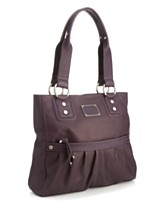
I also rokked my new B. Makowsky Athens tote in purple, which I fondly refer to as "the grape ape". This bag was perfect for carrying all my NYE goodies, camera, and a whole bottle of champagne, which we drank, in addition to the free champagne being handed out by the bar.
Cheers for the rokkin beats by DJs Hecubus, rfbutter, and PrettyTony, among others - thanks for bringing the jams. Cheers for free champage. Cheers for magic marker moustaches.
xoxo
2009: Feelin' Fine!

This year I rokked BCBG Lornas in black on my feet. They were pretty good for dancing until about 3am, when dancing became slightly more impossible....though, I blame the champagne and shots more than the shoes.

I also rokked my new B. Makowsky Athens tote in purple, which I fondly refer to as "the grape ape". This bag was perfect for carrying all my NYE goodies, camera, and a whole bottle of champagne, which we drank, in addition to the free champagne being handed out by the bar.
Cheers for the rokkin beats by DJs Hecubus, rfbutter, and PrettyTony, among others - thanks for bringing the jams. Cheers for free champage. Cheers for magic marker moustaches.
xoxo
2009: Feelin' Fine!
Subscribe to:
Posts (Atom)



